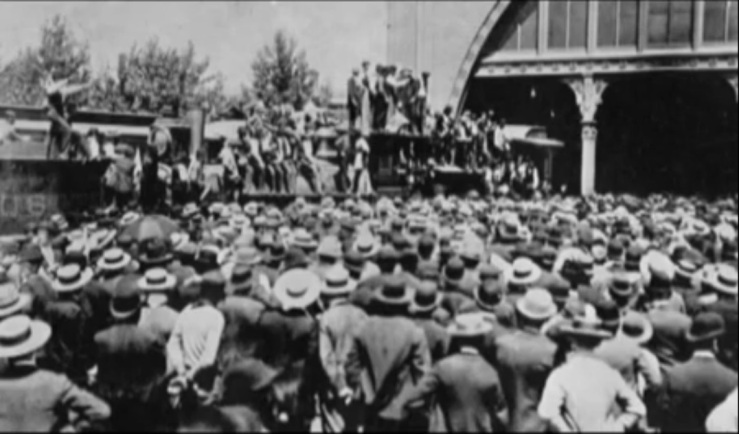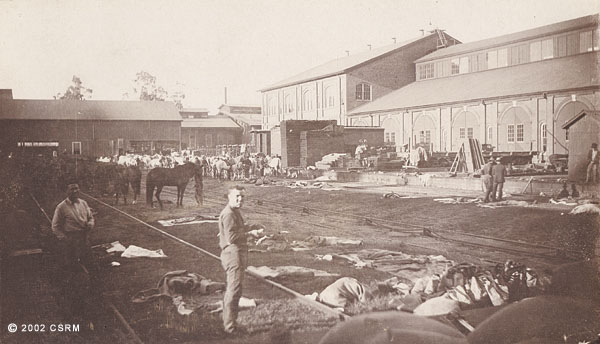
Guest Post by William Burg
On July 4, 1894, two companies of Sacramento militia, bayonets at the ready, faced three thousand strikers at the Southern Pacific passenger depot on Second and H Street, main entrance to the Southern Pacific Shops. The soldiers, all Sacramento residents, stared down their rifles at neighbors, friends, family and coworkers. Their orders were to retake the Shops from the American Railway Union (ARU) strikers, by force if necessary. A third company of Sacramento militia had refused orders and remained at the armory. The strikers, unarmed, had only their bodies to stop the militiamen. “You wouldn’t put that steel through me, would you, Bill?” said one striker to his brother in uniform. “Go ahead, Jack; jab your bayonet through me, and make your sister a widow,” said another. “Go ahead boys, and run us through, we might as well die here as to starve.”

California National Guardsmen in Capitol Park
The Sacramento militia commander, Brigadier General Timothy Sheehan, considered the situation. Behind him were San Francisco guardsmen, exhausted after an overnight trip to Sacramento, poorly fed, and entirely unused to Sacramento’s scorching summer heat. In front of his soldiers were strikers unwilling to yield. And on July 4, any random firecracker could be misinterpreted as a gunshot, setting off a bloodbath. Upon his arrival at the Shops, he saw that the strikers included women and children, even babies, and an atmosphere that seemed more like a picnic than a strike, until his soldiers arrived with fixed bayonets. Sheehan asked strikers to disperse. Major Harris Weinstock, partner in the Weinstock & Lubin department store and Sheehan’s executive officer, repeated the command. The strikers answered in chorus, “You can never enter here unless you do so over our dead bodies.”
The nerve of the militia broke first. Some unloaded their weapons, or even handed their rifles to the strikers. Another company from Stockton retreated to nearby shade, accepting an offer by ARU strikers of iced lemonade (the entire unit was later dishonorably discharged and imprisoned.) Sheehan reported the situation to his superior officer, who turned command over to U.S. Marshal Barry Baldwin. Baldwin dispatched the Sacramento companies to guard the bridges over the Sacramento and American rivers, and climbed atop a locomotive cab, hoping to persuade the strikers with force of oratory where arms had failed, to no avail. The Shops workers cheered as the soldiers returned to the armory at Sixth and M Street, but their victory was short-lived.

Strikers jeer US Marshall Barry Baldwin
The struggle at the Shops began on June 28, 1894, spurred by events half a continent away, at the company-owned town of Pullman, Illinois, home of the Pullman Palace Car Company. Pullman’s patented “sleeper” passenger cars were synonymous with long-distance train travel and used on nearly every railroad. An 1893 depression brought on by railroad bankruptcies and resulting bank failures meant a dramatic drop in Pullman car sales. Pullman cut their employees’ wages by 30%. These wage cuts outraged workers. The company also refused to lower rent in their company-owned housing, and the cuts came just as stockholders received an 8% dividend. Pullman employees, members of the ARU, voted to strike and walked out on May 11, 1894.
On June 27, the strike was still unresolved, and ARU president Eugene V. Debs called on all members belonging to railroads west of Chicago to stop any train with Pullman-owned cars—in other words, nearly every passenger train. The ARU was a new union, founded in 1893 and not officially recognized by the railroads. Some railroad workers, including engineers, firemen and brakemen, already had their own unions, but many, including boilermakers, blacksmiths, and car builders, did not. The ARU was open to all railroad employees, attracting thousands of workers in cities like Pullman and Sacramento, who built or serviced railroad equipment but lacked union representation. In August 1893, the fledgling ARU forced the Great Northern Railway to roll back wage cuts, its first and only victory. The Pullman strike was the second major effort by the new union to exercise its strength, with dramatic results that stopped trains across half the continent.
In 1894, Sacramento was almost as much a company town as Pullman: Southern Pacific employed about one-third of the city’s workforce. SP traditionally had excellent labor relations, but the railroad was far less popular with the general public and the press, who objected to SP’s high rates and monopoly on California traffic. Sacramento Shops employees were not allowed to join existing railroad unions, so ARU membership became very appealing to local workers who sought the benefits that union membership brought their fellow railroad workers. The ARU’s success against Great Northern strengthened that appeal. By the 1890s, California was already one of the most urbanized and industrialized states in the country; only one-fifth of the state population was rural, and new immigration promoted enormous industrial growth in California’s cities, including Sacramento. Even the state’s agricultural resources were organized around industrial production rather than small family farms, using migrant labor on massive corporate farms called “factories in the field” by labor writer Carey McWilliams. The “Panic of 1893” and resulting depression meant many of these workers were unemployed or underpaid.
In April of 1894, only a few weeks before the Pullman strike, “Coxey’s Army,” sometimes called the Industrial Army or the Army of the Unemployed, had passed through Sacramento from the Bay Area on its way to Washington DC, intended as a national protest against economic inequality and unemployment. This group was still marching towards Washington when the Pullman strike started, but California business and government leaders were already alarmed by growing protest and labor unrest throughout the country.
Railroaders across the western United States joined in the boycott. The strike paralyzed railroad traffic across California, including Los Angeles and Oakland, but Sacramento was the hub of the California railroad network and had the largest representation of ARU members. About 2100 of the Shops’ 2500 workers joined the strike, part of an estimated 125,000 strikers nationwide, and hundreds of nearby ARU members came to Sacramento to join the strike. Its timing in deep summer, peak fruit packing season, meant that cars full of fresh fruit rotted on freight platforms and in stopped trains.
Strikers gained a propaganda coup when Jane Lathrop Stanford, widow of former Southern Pacific president Leland Stanford, was stranded in her private railroad car in northern California and wished to return home to San Francisco. She met with the strikers in Dunsmuir and received direct permission from Eugene V. Debs to run her train through Sacramento to her home. Crews decorated the train as a giant pro-strike banner, replacing “SP” (Southern Pacific) on the side of her car with “ARU” spelled out in flowers. Public opinion was swayed, more by antipathy to the railroad than support for the strikers.
Debs and the ARU offered to reopen traffic to non-Pullman trains, but Southern Pacific president Collis P. Huntington refused, and deliberately attached Pullman cars to every train. Huntington saw the chance to eliminate the union by breaking the strike, while compromise would further legitimize the ARU. SP vice-president Henry Huntington (Collis’ nephew) urged other railroad leaders to stand firm: “This is the first strike we have ever had here and as we are making history, [I] think we ought not to take a step backward and make such concession that we will hereafter regret them.”
Another method used by the railroad to avoid compromise was federal leverage. Since many trains included Railway Post Office cars, the strike interfered with the federal mail system. After convincing a U.S. District Court that it was impossible to operate any trains without Pullman cars, Collis Huntington asked for federal help to break the strike, on the grounds that interfering with mail delivery was a federal offense.
In Sacramento, this support came in the form of U.S. Marshal Barry Baldwin, who asked Governor H.H. Markham (marooned in Los Angeles by the strike) to call up the state militia. Troops quickly retook the railroads in Los Angeles, but Sacramento was a more daunting task. On July 3, Baldwin and his marshals tried breaking the strike with a group of deputies, assembling a train in the Southern Pacific yards intended to run through the blockade. Just as the train was assembled, strike leaders gave a pre-arranged signal and strikers rushed the train, disassembling it in a few minutes and thwarting Baldwin’s efforts. Railroad superintendents Wright and Heintzelman were physically removed by strikers when they attempted to start the locomotive. Baldwin tried to break through the crowd and draw his revolver, but was disarmed by strikers. After losing his sidearm, Baldwin gave up and left the depot in strikers’ hands.

Militia marching passed Sixth and L Streets
Strike leaders disavowed violence, but behind the scenes strikers attacked scabs and skirmished with railroad supporters and police. In addition to the guns taken on July 4, strikers took arms from the Bersaglieri Guard, a local Italian militia organization with a small armory. Some thought that the Pullman strike might become the first wave of an armed revolution of Populists and union laborers against the federal government and private industry. Public support for the strike waned as these fears mounted. On July 7, the leaders of the ARU in Chicago were arrested, leaving the strike leaderless as federal forces gathered strength. President Grover Cleveland authorized regular Army troops to relieve the state militias, like the Sacramento soldiers who failed to fire on their friends and family when ordered to do so. More disciplined professional soldiers would have no such qualms.
On July 11, 800 U.S. Army troops arrived in Sacramento via the steamboat Alameda. Colonel Graham of the San Francisco Presidio led two troops of cavalry, five batteries of light artillery, six companies of marines, and one company of regular infantry. Marching up Front Street from the Y Street levee, gunfire was exchanged between strikers and militia, about fifty shots, but without significant casualties.

Soldiers bivouacked at SP Shops
Upon arriving at the depot, the soldiers discovered the ARU had abandoned the Shops the previous night, so they secured the Shops and set up defensive positions. The strikers knew that federal troops would be harder to convince than local militia, and abandoned the Shops on the night of the 10th. The first train west left Sacramento for Oakland later that day, under heavy guard, but was derailed two miles before reaching Davis. Saboteurs had removed spikes and fishplates from the rails, causing a wreck that killed the train’s engineer and three soldiers. On the 13th, troops guarding a train were attacked by gunfire. The soldiers’ return fire killed one striker and wounded another. Popular opinion turned against the strikers in the wake of the sabotage, and by July 18, the Southern Pacific Railroad was back in operation and the Shops reopened. The next day, Debs telegraphed the strikers to open negotiations with the railroad, and the strike formally ended on July 22.

Sabotaged train following Shops strike
During a month of occupation by federal troops, seven people were killed by sabotage or incidents attributed to vengeful soldiers. After the strike, Southern Pacific quietly fired ARU members and blackballed them from future employment. While the strike’s failure was a serious blow for organized labor, only steady nerves, the bonds of community, and perhaps luck prevented a bloody massacre at the entrance to the Southern Pacific Shops.
In the strike’s aftermath, Eugene V. Debs was sent to prison, despite an impassioned defense by Clarence Darrow, a former railroad lawyer who became a labor lawyer after his defense of Debs. Debs ran for President as a socialist, including one campaign run from his prison cell, and founded a new organization, the Industrial Workers of the World, in 1905. Henry Huntington, Collis’ nephew, moved to Los Angeles after the Southern Pacific board of directors did not make him the new board president following Collis Huntington’s death. Major Harris Weinstock was deeply affected by the events of the strike, and wrote a study on labor relations for the State of California, urging employers to negotiate with workers, improve worker conditions, and recognize their right to unionize. In reaction to the failure of local militias to retake the shops, California’s militia system was professionalized into the reorganized California National Guard, including a new Guard armory at Twelfth and X Street. The new Guard and armories were a direct response to labor unrest of this era, including the Pullman strike.
In The Incorporation of America, historian Alan Trachtenberg described the Pullman strike as the victory of corporate power over organized labor, a watershed moment in American labor. Sacramento’s Southern Pacific Shops became the West Coast’s greatest battlefield during that pivotal event in history.



 “Patriotism means to stand by the country. It does not mean to stand by the president or any other public official, save exactly to the degree in which he himself stands by the country. It is patriotic to support him insofar as he efficiently serves the country. It is unpatriotic not to oppose him to the exact extent that by inefficiency or otherwise he fails in his duty to stand by the country. In either event, it is unpatriotic not to tell the truth, whether about the president or anyone else.”
“Patriotism means to stand by the country. It does not mean to stand by the president or any other public official, save exactly to the degree in which he himself stands by the country. It is patriotic to support him insofar as he efficiently serves the country. It is unpatriotic not to oppose him to the exact extent that by inefficiency or otherwise he fails in his duty to stand by the country. In either event, it is unpatriotic not to tell the truth, whether about the president or anyone else.”




